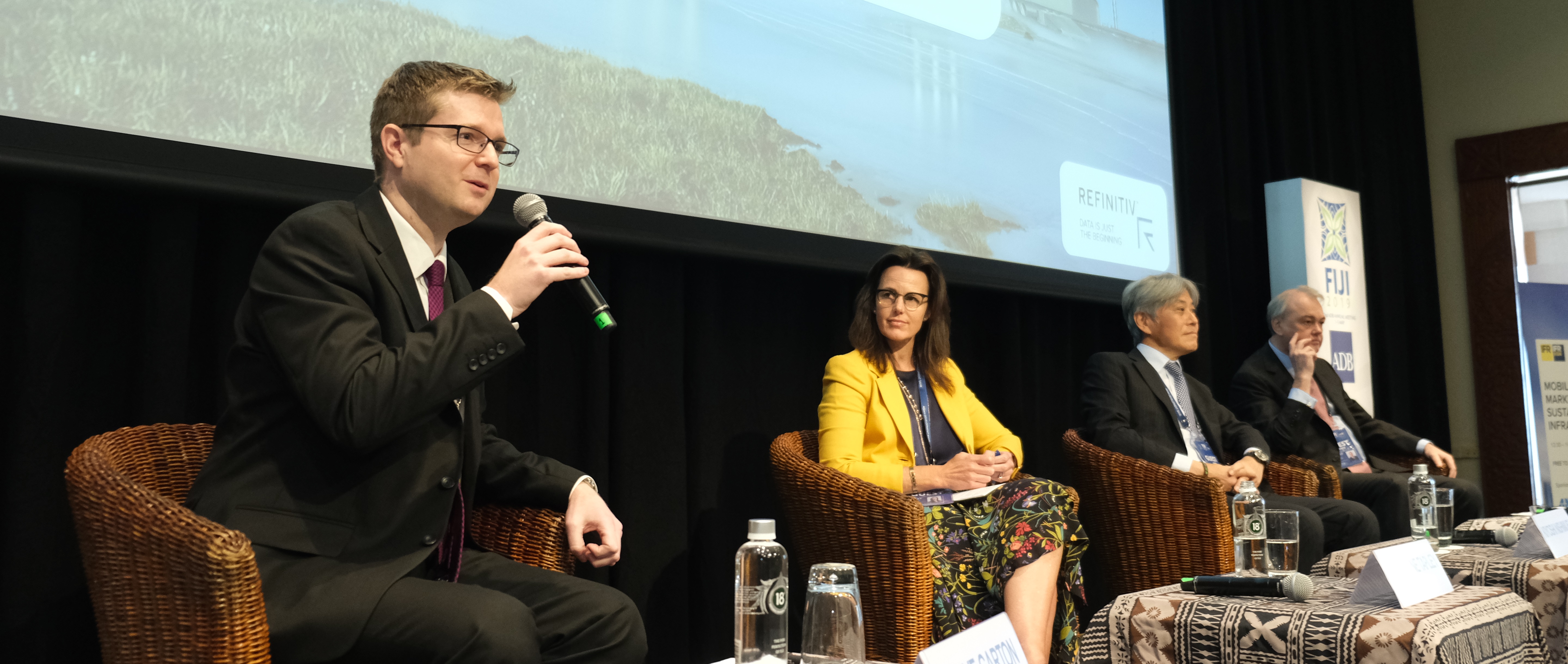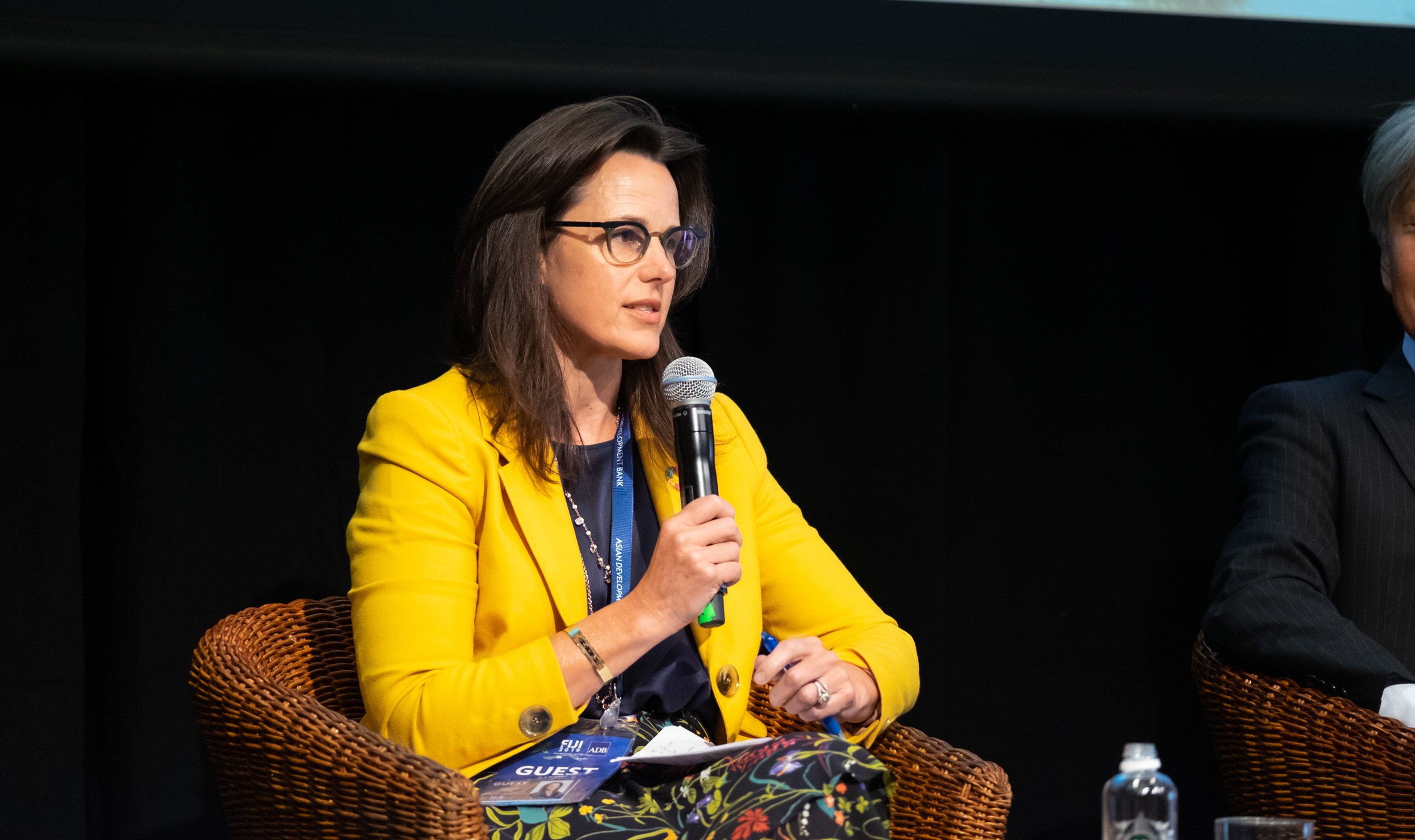Insight
Q&A: sustainability, bonds & the wall
Investors are demanding more conscience from their bonds and issuers are responding in kind. As the growth of sustainability investment continues unabated, what does the future hold?
In May, IFR Asia sat down with ANZ Head of Sustainable Finance Katharine Tapley, Clifford Capital CEO Clive Kerner and Credit Guarantee and Investment Facility (CGIF) CEO Kiyoshi Nishimura to discuss the sector and its outlook on the sidelines of the Asia Development Bank’s Annual Meeting in Fiji. The following are select quotes from that conversation.
You can click here to read the full discussion.

PHOTO: IFR Asia
_________________________________________________________________________________________________________
“There really is no choice, in my view, as to what needs to happen.”
Katharine Tapley, Head of Sustainable Finance, ANZ
_________________________________________________________________________________________________________
KATHARINE TAPLEY: When you think about the already existing effects of climate change, particularly in the Pacific region, the need to fund long-term infrastructure is vital. There really is no choice, in my view, as to what needs to happen and I think the sustainable finance markets have a very significant role to play.
We’re seeing significant appetite from investors for so-called green assets but there is a broader concept around sustainability and sustainable development. There is an absolute wall of capital there waiting to be deployed into infrastructure that helps economies and the broader region to sustain their economies for the long term.
Steve Garton, IFR Asia: Nishimura san, what’s the role of the local capital markets?
KYOSHI NISHIMURA: Sustainable infrastructure projects are projects which are sustainable in terms of their climate or environment or social impact. How these assets are financed is also important. Infrastructure projects need long-term funds because of their long-term payback period. Many projects rely on revenues that come only after they are completed.
When we talk about finance in the domestic financial system it still means, in most Asian countries, we are talking about the banking system. The financiers are local banks, which may still create a problem in asset/liability mismatches in the banking system, because banks basically rely on short-term deposits to finance these long-term assets.
Long-term infrastructure projects – especially sustainable infrastructure projects – should be really financed with long-term, local currency funds in the bond market.
In emerging Asia, you don’t really see many project bonds. Malaysia is the only country in Asia that has successfully developed a project bond market. It’s the fastest growing green bond market in the world and has become already the global leader in the green bond market.
IFR ASIA: Katharine, can you give us a little bit more of an update on recent developments?
KT: Our experience is every time we go out on a roadshow – whether it’s for ANZ or for a client in New Zealand, Australia, or anywhere in Asia – there are always more investors wanting access to green, social or sustainability bonds. We’re certainly seeing an increase in appetite, and a change in the way these portfolios are being made up.
The other trend and interesting development we see is the broadening of asset classes to which these transactions can be applied. Initially the green bond market was dominated by renewable energy – solar farms, wind farms, for example. We’ve seen a broadening of that into transportation, in particular, and sustainable land use.

PHOTO: IFR Asia
IFR ASIA: So does that mean anybody can issue a green bond?
KT: It’s not quite that simple. Under the Green Bond Principles, you do need a green or definable asset base for a start, so that can present challenges. For us – as an arranger and certainly also as an issuer – it’s really important there is an agenda and a strategy around sustainability.
IFR ASIA: Nishimura san, I understand green bonds are a growing focus for you?
KN: Actually this is really my favourite subject. To see where we are going, we need to really understand the context of green bonds in developing and more developed countries.
Green bonds started in the developed markets in Europe and North America and have grown quite significantly, and their growth was market-driven because there are dedicated investors for green or socially responsible bonds. However, if you look at the development of green bonds in emerging Asia, the situation is different.
China now has become the second-largest green bond market globally within a few years but it was not created by a market-driven or bottom-up approach. Basically domestic bond investors don’t really differentiate between green bonds or normal conventional bonds. It was policy-driven, because regulators introduced guidelines and encouraged issuers to sell green bonds.
The challenge for developing countries is if you want to really grow the green bond market to a sustainable level, you need to create a domestic bond investor base which is really dedicated to investing in green bonds.
That means first of all it’s very important to raise awareness of why green bonds are important, and the impact of ESG on investment decisions. There may be some regulatory ways to incentivise investors to invest in the green bond. Otherwise it’s going to continue to be policy-driven, so it may not be really sustainable in the long term.
IFR ASIA: If there’s no dedicated investor base, what’s the advantage to an issuer from making your financing green?
KT: Typically with these transactions we tend to see more investors coming in and in much greater volume. So you are tapping into brand new money, as well as new funds within existing investors you didn’t previously have access to. That diversity and granularity has to be an advantage to a borrower and that’s a trend we’re seeing right across our region.
The other piece that often gets underestimated when a borrower goes into a transaction is the strengthening of the relationship with their investor base.
The key difference with the green bond market is a well-structured green or sustainability bond comes with a whole lot of transparency and reporting. That’s an advantage both to the issuer and the investor, because they get this dialogue that wasn’t otherwise there.
IFR ASIA: If I’m an investor, how do I know my money is going towards sustainable development, and not a company’s next coal plant?
KT: The principles around green and sustainability bonds are very clear in making a very strong recommendation to provide regular reporting and transparency on how the money has been used.
Investors are not just sitting back and getting themselves into green bonds and then not following up on the reporting. They will want to see reporting at least annually, sometimes twice a year, not on just how proceeds have been used but also what the impact of that money has been.
The sustainable development goals are increasingly becoming a framework, if you like, through which investors are actually measuring that impact.
IFR ASIA: What more can be done to stimulate sustainable financing?
KT: Both Singapore and Hong Kong regulators have now put in place programs whereby they will help pay the costs for issuers wanting to sell bonds and list them on those stock exchanges. That’s very helpful to stimulate interest at least, even though it’s a little bit of a myth these transactions come with extra costs.
On the investor side, as I said before, I’m not sure they need a whole lot of incentivisation to come into these transactions. There is just not enough supply in the market.
As I said earlier, appetite for sustainable or green investments is increasing, and fund managers are under pressure themselves to demonstrate their commitment there. I only see that going one way.
IFR ASIA: Clive, is that something you’ve seen as well, that there’s basically a lot of money chasing assets at the moment?
CLIVE KERNER: This is something everyone talks about and it’s absolutely the case in Asia. There’s still too much liquidity chasing too few projects.
I think where it all really starts is host governments need to do more to work out which projects are commercially viable and therefore can be offered to the private sector, and which are not and therefore should stay with the public sector.
People talk about $US6 trillion of demand for infrastructure in Asia. Clearly governments can’t fund all of that, so there’s a clear role for the private sector. That’s a really important initiative.
IFR Asia: What happens when the market changes or interest rates go up, how will green bonds work then?
KT: We haven’t really seen yet a lot of stress where these bonds have been tested. Our view is– and we have seen some evidence already – they do tend to perform better than existing vanilla bonds in a tough market.
I think that speaks to the quality and the structure of the transactions, as well as the underlying nature of what the proceeds have been used for. I think it speaks to what investors want to be holding as well.
This story consists of collected excerpts from a Q&A hosted by IFR Asia.
RELATED INSIGHTS AND RESEARCH
insight

The Genesis of an investment for good
Social impact financing like the G-Fund Social Investment Bond is helping parties on both sides of the investment aisle.
insight

APAC’s biggest sustainable loan takes flight
Sydney Airport’s landmark sustainability linked loan hits milestones in Australia and Asia Pacific.
insight

Go low: supporting the drive to a net-zero emissions economy
ANZ is helping our customers adapt to the transition to a low-carbon economy.